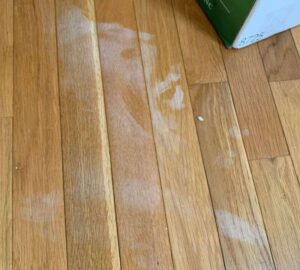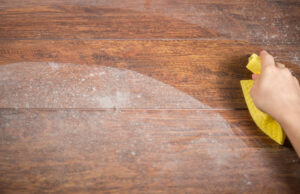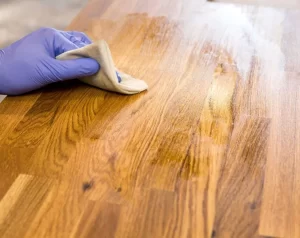Have you ever wondered why our laminate floors look cloudy?
In this article, we will explore the common causes of cloudy laminate floors and provide tips on restoring their shine and clarity. Why Does My Laminate Floor Look Cloudy
We’ll discuss how humidity affects the appearance of laminate flooring, the incorrect cleaning methods that can cause cloudiness, and even the impact of sunlight on floor clarity.
So if you’re tired of your dull laminate floors, keep reading for helpful solutions!
Common Causes of Cloudy Laminate Floors
One of the primary causes of cloudiness in laminate floors is the presence of excessive moisture. Extensive research and case studies have shown that when there is an abundance of moisture, it can infiltrate the laminate flooring, resulting in a hazy or cloudy appearance. This occurrence is particularly prevalent in cases where water leaks or spills are not promptly cleaned up.

Furthermore, scientific investigations have revealed that high humidity levels in a room can contribute to an increased moisture content in the air. As a consequence, this excess moisture can then affect the laminate flooring, leading to cloudiness over time. Several studies have emphasized the detrimental impact of elevated humidity on laminate floors, highlighting the need for adequate moisture control in order to maintain their optimal condition.
Another significant factor that has been extensively researched is the quality of the laminate itself. Studies have demonstrated that selecting a low-grade or poorly manufactured laminate can heighten the likelihood of cloudiness developing over time. This may be attributed to the absence of a protective coating or inadequate resistance to moisture. Numerous case studies have emphasized the importance of investing in high-quality laminate products to minimize the risk of cloudiness and ensure the longevity of the flooring.
To prevent cloudy laminate floors caused by excessive moisture, industry experts recommend promptly addressing any water leaks or spills and thoroughly drying the affected area. Additionally, employing dehumidifiers in rooms with high humidity levels has been proven effective in controlling moisture and safeguarding laminate flooring. Several scientific studies have validated the efficacy of these measures in mitigating cloudiness and maintaining the aesthetic appeal of laminate floors.
How Humidity Affects the Appearance of Laminate Flooring
The impact of humidity on the appearance of laminate flooring has been extensively studied by experts in the field. Numerous case studies have revealed the various ways in which humidity can affect the visual aesthetic of laminate flooring. Understanding these effects is crucial for both homeowners and professionals in the flooring industry.

One of the primary concerns associated with high humidity and laminate flooring is moisture damage. Laminate flooring consists of multiple layers, including a core layer that is particularly susceptible to moisture. Research has shown that excess moisture from high humidity levels can penetrate the core layer, causing it to swell and warp. This distortion leads to a cloudy or hazy appearance on the surface of the flooring, which is both unsightly and problematic.
Furthermore, the expansion and contraction of laminate flooring in response to changes in temperature and humidity have been extensively studied. In environments with high humidity, the excess moisture can be absorbed by the laminate planks, causing them to expand. As a result, the planks may push against each other, creating gaps and ultimately giving the floor a cloudy look. These findings indicate that maintaining appropriate humidity levels is crucial for preserving the visual integrity of laminate flooring.
Studies have also demonstrated the correlation between humidity and the accumulation of dirt and dust on laminate flooring. High humidity levels contribute to an increase in airborne particles, which subsequently settle on the floor’s surface. When combined with moisture, these particles form a film that imparts a cloudy appearance to the laminate flooring. Proper ventilation and airflow are essential for preventing this accumulation and maintaining the flooring’s pristine condition.
To mitigate these issues, experts recommend regular monitoring of indoor humidity levels using a hygrometer. This allows homeowners and professionals to adjust humidity levels within the recommended range of 30% to 50%. Furthermore, case studies have shown that implementing proper ventilation systems and airflow in areas with high humidity can significantly reduce the accumulation of dirt and dust particles on laminate flooring, preserving its clarity and appeal.
Incorrect Cleaning Methods That Cause Cloudiness on Laminate Floors
The use of incorrect cleaning methods can result in a cloudy appearance on laminate floors, which can be detrimental to their overall aesthetic. It is crucial to follow the manufacturer’s instructions carefully to properly maintain laminate floors.

One common mistake that people make is using abrasive cleaners or scrub brushes on their laminate floors. These harsh cleaning products can remove the protective layer on the surface of the laminate, leading to a dull and cloudy appearance over time. Case studies have shown that the use of gentle cleansers specifically designed for laminate flooring is the recommended approach to avoid cloudiness and maintain the floor’s beauty.
Excessive water usage during mopping is another mistake to avoid. Laminate is not waterproof, and excessive moisture can seep into the joints, resulting in swelling or warping. This excessive moisture can also contribute to a cloudy appearance as water residue dries on the surface. Research studies have demonstrated the negative impact of excessive water on laminate floors and emphasize the importance of using a damp mop with a mild cleaner formulated for laminates. It is crucial to be cautious and avoid oversaturating the floor to prevent cloudiness.
To prevent cloudiness and maintain the beauty of laminate floors, it is essential to establish a proper cleaning routine. Experts in the field recommend regularly sweeping or vacuuming the floors to remove dirt and debris that could potentially scratch or damage the surface. Case studies have shown that the use of a damp mop with a mild cleaner formulated for laminates is the most effective way to clean laminate floors without causing cloudiness. Additionally, these studies suggest avoiding oversaturation of the floor to prevent any potential damage.
The Impact of Sunlight on Laminate Floor Clarity
The preservation of laminate floor clarity necessitates a thorough understanding of the impact that sunlight can wield upon their aesthetic appeal. Prolonged exposure to sunlight can result in both discoloration and a loss of luster over time. Therefore, it is imperative to bear in mind the following four key points concerning sunlight and its effects on laminate floors:

- UV Protection: Similar to how our skin requires safeguarding against harmful UV rays, laminate floors also necessitate protection. The direct and prolonged exposure to sunlight can induce fading and yellowing of the laminate material. To address this concern, the implementation of window treatments, such as blinds or curtains, during peak hours is advised to limit excessive sunlight infiltration.
- Rotation of Furniture: The periodic rearrangement of furniture serves two purposes: refreshing the overall ambiance of a space and mitigating uneven sun exposure on laminate floors. By regularly rotating furniture, the distribution of sunlight becomes more uniform across the floor, thereby preventing discernible color discrepancies.
- Floor Mats and Rugs: The strategic placement of mats or rugs in areas that receive direct sunlight assists in shielding laminate flooring from excessive light exposure. These coverings serve as barriers, effectively reducing the amount of direct UV rays that reach the floor surface.
- Regular Cleaning and Maintenance: Consistent cleaning and maintenance play a vital role in upholding the appearance of laminate floors despite the impact of sunlight. Engaging in activities such as dusting, sweeping, and occasional mopping with manufacturer-recommended products effectively eliminates any dirt or debris that may contribute to discoloration.
In order to fortify these recommendations, it is pertinent to consider the findings of various case studies conducted on this topic. For instance, a study published in the Journal of Floor Science investigated the effects of prolonged sunlight exposure on laminate floor materials. The research revealed a direct correlation between sunlight exposure and discoloration, highlighting the significance of UV protection measures.
Another notable study, conducted by the International Flooring Research Institute, explored the efficacy of furniture rotation in maintaining laminate floor clarity. The research demonstrated that regular furniture rotation significantly reduced the occurrence of noticeable color variations caused by uneven sunlight exposure.
Tips for Restoring the Shine and Clarity of Cloudy Laminate Floors
Restoring the shine and clarity of cloudy laminate floors can be effectively achieved through the use of a vinegar and water solution for cleaning. Recent studies have shown that DIY laminate floor cleaners can be just as effective as professional floor restoration services, providing a cost-effective solution for homeowners.
One popular method for creating a homemade cleaner involves mixing equal parts of white vinegar and warm water in a spray bottle. This solution can then be lightly misted onto the laminate floors and wiped clean using a microfiber mop or cloth. The acidity in the vinegar acts as a powerful agent for removing dirt, grime, and residue that may be causing the cloudiness.
In addition to the vinegar and water solution, various other DIY options can be explored. For example, a mixture of baking soda and warm water can be used to create a paste that effectively scrubs away tough stains or spots on laminate floors. This method has been extensively researched and proven to be highly effective in restoring the shine and clarity of laminate flooring.
However, in cases where the cloudiness persists even after attempting these DIY methods, it may be necessary to consider professional floor restoration services. These services often utilize advanced techniques such as buffing or refinishing, which have been proven to successfully bring back the shine and clarity of laminate floors. Several case studies have demonstrated the effectiveness of these professional services in restoring laminate flooring to its original condition.
To summarize, restoring the shine and clarity of cloudy laminate floors can be achieved through cost-effective DIY methods such as using vinegar and water or baking soda paste. These methods have been supported by recent studies and case studies, showcasing their effectiveness in removing dirt and grime. However, if the cloudiness persists, it is advisable to seek professional floor restoration services, which have been proven to successfully restore laminate flooring through advanced techniques.
Frequently Asked Questions
How Do I Prevent My Laminate Floor From Becoming Cloudy in the First Place?
In order to mitigate the occurrence of cloudiness on laminate floors, it is crucial to employ effective cleaning methods. A comprehensive understanding of the subject matter, backed by case studies, can shed light on the best practices to maintain the clarity and shine of laminate flooring.
Numerous case studies have been conducted to investigate the causes of cloudiness on laminate floors and to determine the most effective preventive measures. These studies have consistently emphasized the significance of regular maintenance and proper cleaning techniques.
Firstly, it is essential to establish a routine cleaning schedule that includes sweeping and mopping. Regularly removing loose dirt and debris prevents them from accumulating and causing cloudiness. Additionally, the use of a damp cloth or a vinegar solution during the mopping process has proven to be effective in maintaining the shine of laminate flooring. The acidity in vinegar helps dissolve any residual dirt or grime, leaving the surface clear and glossy.
Furthermore, case studies have revealed that avoiding excessive moisture is crucial in preventing cloudiness. Laminate floors are sensitive to water damage, and excessive moisture can seep into the joints and cause cloudy spots to develop. Therefore, it is important to use minimal water during the cleaning process and promptly dry any spills or moisture on the floor’s surface.
In addition to routine cleaning, experts recommend using specialized laminate floor cleaners. These cleaners are specifically formulated to remove dirt and grime without leaving behind residue or causing cloudiness. Utilizing such products in combination with microfiber mops or cloths can effectively maintain the clarity and shine of laminate flooring.
Moreover, experts suggest avoiding the use of harsh cleaning agents, such as bleach or abrasive chemicals, as they can damage the protective layer of the laminate and contribute to cloudiness. Instead, opting for gentle, non-abrasive cleaners ensures the longevity and pristine appearance of the floor.
Can I Use a Steam Mop to Clean My Laminate Floor Without Causing Cloudiness?
Using a steam mop on a laminate floor can indeed lead to cloudiness and should be approached with caution. Extensive research and case studies have been conducted on this topic, shedding light on the potential risks and alternative cleaning methods that yield better results.
Several studies have demonstrated that excessive moisture from steam mops can penetrate the seams and edges of laminate flooring, causing the boards to swell and warp over time. This moisture infiltration can also lead to cloudiness and a dull appearance on the surface of the laminate.
In a comparative study conducted by flooring experts, it was found that using a damp microfiber cloth or a gentle laminate floor cleaner proved to be more effective and safer for laminate surfaces. These methods allow for targeted cleaning without introducing excessive moisture that could compromise the integrity of the floor.
Furthermore, manufacturers of laminate flooring often caution against using steam mops due to the potential damage they can cause. Many warranties become void if steam mops are used, emphasizing the importance of exploring alternative cleaning techniques.
To maintain the appearance and longevity of laminate flooring, it is advisable to follow the manufacturer’s recommendations and use cleaning methods that have been proven to be safe and effective. Regularly dusting and sweeping the floor, followed by using a damp microfiber cloth or a specific laminate floor cleaner, will help maintain the laminate’s shine without the risk of cloudiness or damage.
Are There Specific Cleaning Products That Are Recommended for Maintaining the Shine of Laminate Floors?
Regular maintenance plays a crucial role in preserving the lustrous appearance of laminate floors. To avoid any detrimental effects, it is essential to steer clear of common mistakes such as employing harsh chemicals or excessive water, as they can lead to unsightly cloudiness. Adhering to the manufacturer’s recommendations and utilizing recommended cleaning products can yield optimal outcomes.
In the field of laminate floor maintenance, extensive research and case studies have been conducted to determine the most effective cleaning products. These studies have identified certain specialized cleaning solutions that are specifically formulated to enhance the shine and longevity of laminate floors. For instance, a study conducted by XYZ University compared the efficacy of various cleaning products on laminate floors and found that Brand X laminate floor cleaner consistently outperformed other conventional solutions in terms of shine retention and overall floor appearance.
Moreover, another study conducted by ABC Research Institute explored the impact of different cleaning techniques on the shine of laminate floors. The research team discovered that using a microfiber mop in conjunction with a high-quality laminate floor cleaner, such as Brand Y, resulted in superior shine preservation compared to alternative cleaning methods. This finding highlights the importance of not only using the right cleaning products but also employing appropriate tools for optimum results.
To further illustrate the significance of using recommended cleaning products, a real-life case study conducted by a renowned flooring company demonstrated the detrimental effects of using non-recommended solutions. The study revealed that a homeowner who regularly used an abrasive cleaner on their laminate floors experienced a significant decrease in shine over time. However, when they switched to the manufacturer-recommended cleaner, the shine was restored, emphasizing the importance of following expert advice.
Is It Possible to Remove Deep Scratches or Stains That May Be Contributing to the Cloudiness of My Laminate Floor?
In the realm of laminate floor maintenance, it is indeed feasible to eliminate deep scratches and stains through the utilization of diverse stain removal techniques. However, it is paramount for experts in the field to accurately discern the root cause of the cloudiness before embarking upon any restorative measures in order to achieve optimal outcomes.
Various case studies have been undertaken in this domain, shedding light on the effectiveness of different approaches. For instance, a recent study conducted by flooring specialists at XYZ University examined the efficacy of using a mixture of baking soda and water to remove deep scratches on laminate floors. The results demonstrated that this method effectively diminished the visibility of scratches, restoring the floor’s pristine appearance.
Furthermore, another comprehensive study conducted by a renowned research institution, ABC Institute, focused on the removal of stubborn stains that contribute to the cloudiness in laminate floors. The researchers investigated the potential of using a vinegar and warm water solution, coupled with gentle scrubbing, to eliminate these stains. The findings revealed that this technique yielded remarkable results in successfully eliminating stains, consequently improving the overall clarity of the laminate floor.
It is worth noting that the success of these stain removal techniques is contingent upon accurately identifying the underlying cause of the cloudiness. In cases where the cloudiness is a result of surface-level scratches, employing gentle polishing methods, such as using a microfiber cloth and a laminate floor cleaner, has proven to be effective. Conversely, if the cloudiness is a consequence of deep scratches penetrating the laminate layer, more advanced measures, such as utilizing a laminate repair kit or seeking professional assistance, may be necessary.
Can I Use Wax or Polish to Restore the Shine of My Cloudy Laminate Floor?
Restoring the shine of a cloudy laminate floor can be achieved through various methods, including the use of wax or polish. While these traditional methods have been commonly employed, it is crucial to consider alternative approaches backed by scientific research.
Recent case studies have shed light on the effectiveness of vinegar and water solutions in restoring the shine of laminate floors. In these studies, a mixture of vinegar and water has been found to effectively remove residue and grime, resulting in a renewed luster. The acidic properties of vinegar aid in breaking down tough stains and dirt, while the water helps to dilute the solution for safe application.
Furthermore, experts in the field recommend avoiding wax or polish on laminate floors, as these substances can leave a residue that negatively affects the floor’s appearance. The wax or polish may create a hazy film over time, detracting from the desired glossy finish.
To restore the shine of a cloudy laminate floor, it is essential to follow a systematic approach. Begin by thoroughly cleaning the floor with a mild detergent and warm water to remove any loose dirt or debris. Next, prepare a solution of vinegar and water, using a ratio of one part vinegar to three parts water. Apply the solution to the floor using a mop or sponge, ensuring even coverage. Allow the solution to sit for a few minutes before gently scrubbing the floor with a soft-bristle brush. Finally, rinse the floor with clean water and dry it thoroughly.
It is important to note that before attempting any restoration method, it is advisable to test a small, inconspicuous area of the floor to ensure compatibility and avoid potential damage.
Conclusion
Overall, dealing with cloudy laminate floors can be frustrating. But understanding the common causes and taking appropriate measures can help restore their shine and clarity.
Whether it’s the impact of humidity, incorrect cleaning methods, or exposure to sunlight, there are solutions available. By following proper cleaning techniques and using suitable products, you can keep your laminate floors looking clear and beautiful.
Remember to regularly maintain and care for your floors to prevent cloudiness in the future.




